Related Research Articles
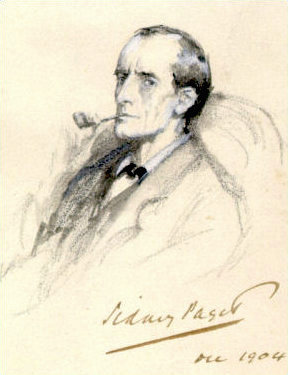
Sherlock Holmes is a fictional detective created by British author Arthur Conan Doyle. Referring to himself as a "consulting detective" in his stories, Holmes is known for his proficiency with observation, deduction, forensic science and logical reasoning that borders on the fantastic, which he employs when investigating cases for a wide variety of clients, including Scotland Yard.

Professor James Moriarty is a fictional character and criminal mastermind created by Sir Arthur Conan Doyle to be a formidable enemy for the author's fictional detective Sherlock Holmes. He was created primarily as a device by which Doyle could kill Holmes and end the hero's stories. Professor Moriarty first appears in the short story "The Adventure of the Final Problem", first published in The Strand Magazine in December 1893. He also plays a role in the final Sherlock Holmes novel The Valley of Fear, but without a direct appearance. Holmes mentions Moriarty in five other stories: "The Adventure of the Empty House", "The Adventure of the Norwood Builder", "The Adventure of the Missing Three-Quarter", "The Adventure of the Illustrious Client", and "His Last Bow".
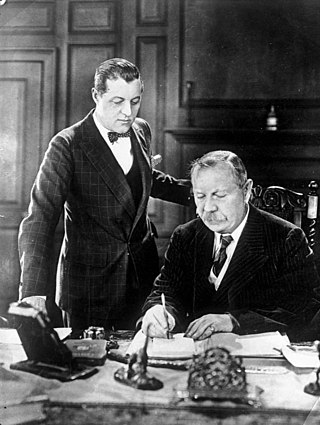
Adrian Malcolm Conan Doyle was the youngest son of Sir Arthur Conan Doyle and his second wife Jean, Lady Doyle or Lady Conan Doyle. He had two siblings, sister Jean Conan Doyle and brother Denis, as well as two half-siblings, sister Mary and brother Kingsley.

George Edward Challenger is a fictional character in a series of fantasy and science fiction stories by Sir Arthur Conan Doyle. Unlike Doyle's self-controlled, analytical character, Sherlock Holmes, Professor Challenger is an aggressive, hot-tempered, dominating figure.
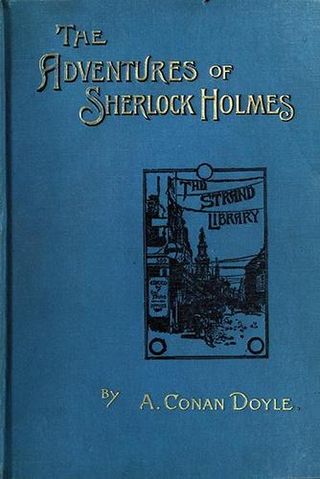
The Adventures of Sherlock Holmes is a collection of short stories by British writer Arthur Conan Doyle, first published on 14 October 1892. It contains the earliest short stories featuring the consulting detective Sherlock Holmes, which had been published in twelve monthly issues of The Strand Magazine from July 1891 to June 1892. The stories are collected in the same sequence, which is not supported by any fictional chronology. The only characters common to all twelve are Holmes and Dr. Watson, and all are related in first-person narrative from Watson's point of view.

The Case-Book of Sherlock Holmes is the final set of twelve Sherlock Holmes short stories by British writer Arthur Conan Doyle first published in the Strand Magazine between October 1921 and April 1927.

221B Baker Street is the London address of the fictional detective Sherlock Holmes, created by author Sir Arthur Conan Doyle. In the United Kingdom, postal addresses with a number followed by a letter may indicate a separate address within a larger, often residential building. Baker Street in the late 19th century was a high-class residential district, and Holmes's apartment would probably have been part of a Georgian terrace.

Arthur & George (2005) is the tenth novel by English author Julian Barnes which takes as its basis the true story of the "Great Wyrley Outrages".

The Hound of the Baskervilles is a 1959 British gothic mystery film directed by Terence Fisher and produced by Hammer Film Productions. It is based on the 1902 novel of the same title by Sir Arthur Conan Doyle. It stars Peter Cushing as Sherlock Holmes, Sir Christopher Lee as Sir Henry Baskerville and André Morell as Doctor Watson. It is the first film adaptation of the novel to be filmed in colour.
"A Study in Emerald" is a short story written by British fantasy and graphic novel author Neil Gaiman. The story is a Sherlock Holmes pastiche transferred to the Cthulhu Mythos universe of horror writer H. P. Lovecraft. Gaiman describes it as "Lovecraft/Holmes fan fiction". It won the 2004 Hugo Award for Best Short Story. The title is a reference to the Sherlock Holmes novel A Study in Scarlet.

Traditionally, the canon of Sherlock Holmes consists of the 56 short stories and four novels written by Sir Arthur Conan Doyle. In this context, the term "canon" is an attempt to distinguish between Doyle's original works and subsequent works by other authors using the same characters. Usually capitalized by fans of the Sherlockian game as "the Canon", the description of these 60 adventures as the Sherlock Holmes canon and the game of applying the methods of "Higher Criticism" to it was started by Ronald Knox as a playful use of the traditional definition of canon as an authoritative list of books accepted as holy scripture.

Sir Arthur Ignatius Conan Doyle was a British writer and physician. He created the character Sherlock Holmes in 1887 for A Study in Scarlet, the first of four novels and fifty-six short stories about Holmes and Dr. Watson. The Sherlock Holmes stories are milestones in the field of crime fiction.

"Lot No. 249" is a Gothic horror short story by British writer Arthur Conan Doyle, first published in Harper's Magazine in 1892. The story tells of a University of Oxford athlete named Abercrombie Smith who notices a strange series of events surrounding Edward Bellingham, an Egyptology student who owns many ancient Egyptian artefacts, including a mummy. After seeing his mummy disappear and reappear, and two instances of Bellingham's enemies being attacked, Smith concludes that Bellingham is re-animating his mummy.

The Speckled Band is a 1931 British mystery film directed by Jack Raymond and starring Lyn Harding, Raymond Massey and Angela Baddeley. It is an adaptation of Arthur Conan Doyle's original 1892 story "The Adventure of the Speckled Band" and the 1910 play he adapted from it, The Speckled Band.
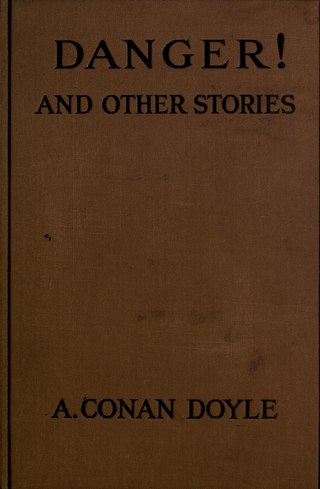
Danger! And Other Stories is a collection of short stories by Sir Arthur Conan Doyle published in 1918.

Sir Arthur Conan Doyle KStJ, DL (1859–1930) was a Scottish writer and physician. In addition to the series of stories chronicling the activities of Sherlock Holmes and his friend Dr John Watson for which he is well known, Doyle wrote on a wide range of topics, both fictional and non-fictional. In 1876 Doyle entered the University of Edinburgh Medical School, where he became a pupil of Joseph Bell, whose deductive processes impressed his pupil so much that the teacher became the chief model for Holmes. Doyle began writing while still a student, and in October 1879 he had his first work—"The Mystery of the Sasassa Valley"—published in Chambers's Journal. He continued writing short works—both fictional and non-fictional—throughout his career, and had over 200 stories and articles published.

The Narrative of John Smith (2011) is a novel written in 1883 by Arthur Conan Doyle, published posthumously by The British Library. In a work of narrative fiction, Doyle writes from the perspective of a middle-aged bachelor named John Smith recovering from rheumatic gout. Unlike his later work in detective fiction, fantasy, and science fiction, this novel unfolds through a series of tangential, essay-like thoughts stemming from observations on everyday life. The subjects are of a “personal-social-political complexion”.

A Duet, with an Occasional Chorus is a novel by British author Sir Arthur Conan Doyle, published in 1899 by Grant Richards in the UK and D. Appleton in the US. The novel features the story of a happily married couple which is threatened by a previous lover of the husband. Conan Doyle hoped that this would be his most successful novel to date, but the novel was widely panned for being banal and inane.
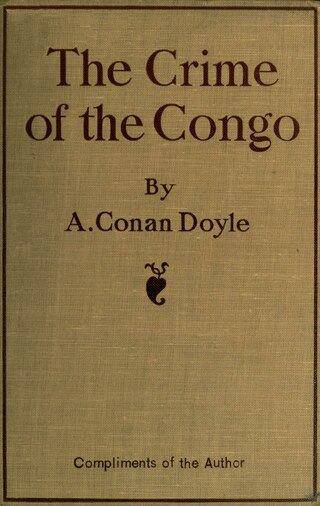
The Crime of the Congo is a 1909 book by British writer and physician Sir Arthur Conan Doyle, about human rights abuses in the Congo Free State, a private state established and controlled by the King of the Belgians, Leopold II.

Sherlock Holmes and Doctor Watson is a television series created by Sheldon Reynolds and based on characters and storylines from Sir Arthur Conan Doyle's Sherlock Holmes stories. It starred Geoffrey Whitehead, Donald Pickering and Patrick Newell in the title roles of Sherlock Holmes, Doctor Watson and Inspector Lestrade respectively. The series is considered rather obscure, and was filmed on a relatively low budget in Poland. The series combined adaptations of Arthur Conan Doyle's source stories with original screenplays that saw Holmes face brand new cases.
References
- 1 2 Watts, Jarica (2017). "Submerged by Fear: The Politics of Wartime Hysteria in Conrad and Conan Doyle". Conradiana . 49 (1): 17–41. ISSN 1935-0252 – via Project MUSE.